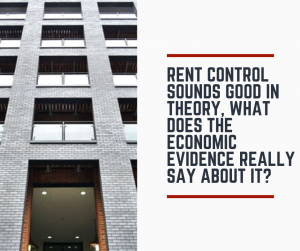05 Nov Rent Control Sounds Good in Theory, What Does the Economic Evidence Really Say About It?
The battle over rent control has been raging in California for years and thanks to the recent passage of AB 1482, we’re seeing California become a pro-rent control state
Even though rent control advocates tout the benefits that it offers tenants, the big question is what does the economic evidence have to say about how it affects landlords and communities.
The good and bad news is that rent control has been implemented before in other cities nationwide, and ultimately repealed, so there are some documented cases which shed light on the failures of rent control and provide us with insight into what we can expect in California.
Rent Control Creates A Mis-Match Between Tenants
Thanks to data from a variety of studies including the Brookings Institute, (Suen 1980, Glaeser and Luttmer 2003, Sims 2011, Bulow and Klemperer 2012), we know that rent control often produces a rental unit “mismatch” between tenants who are living in rent-controlled communities.
For example: in cities like New York, where rent control has been a part of life for decades, older tenants who live in rent-controlled apartments (between 8-9 percent of tenants) are often hesitant to leave those units for smaller apartments because they don’t want to lose their rent control.
On the “flipside”, younger tenants who may be starting families are unable to move up to bigger rentals in their areas because of the older tenants who are hesitant to give up on their rent-controlled units even though they may “empty nesters” and not need the space that their current rentals offer them.
Rent Control Is Responsible for Keeping Neighboring Property Values Low
Even though supporters of rent control often praise the benefits that it offers tenants, the big question is how do rent control measures affect property owners?
Based on studies from cities that formally had rent control measures in place, then voted to eliminate rent control, we know that rent control kept their property values low and negatively affected the values of other properties in nearby neighborhoods as well.
What happened to those properties when rent control was eliminated? Thanks to data from Palmer, and Pathak (2014) (APP), we know that properties in cities where rent control was ended actually saw their values increase by 45 percent. What’s even better is that surrounding neighborhoods also saw their property values increase as well just from eliminating rent control.
A real-life example of this is Cambridge, MA, a city that had rent control measures in place from 1970 to 1994 on any properties that were built prior to 1969.
Once rent control was eliminated in Cambridge in 1994, owners of those formally rent-controlled properties saw their values increase by roughly $2 billion between 1994 and 2004.
Will Rent Control Be Different for California?
With the negative effects of rent control documented widely, and easily found online, it’s easy to wonder if California’s attempt at statewide rent control is going to be different than what’s been tried in other cities and states in previous years?
Sadly, the answer to this question appears to be no. As long as lawmakers fail to recognize that the main cause of rents being unaffordable in California is largely due to a supply and demand problem, we’re going to continue to have the same problems statewide for years to come.
Contact MW Realty Group
MW Realty Group is your source for full-service property management in Los Angeles. We’re experts at sourcing, acquiring, and managing investment properties. To learn more about the services we can offer you, contact us today at (213) 927-2117 or connect with us online.







